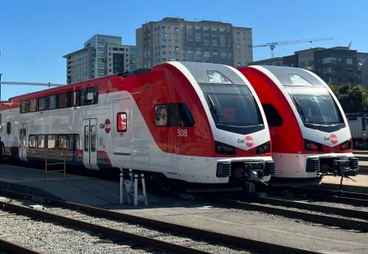Note: GJEL Accident Attorneys regularly sponsors coverage on Streetsblog San Francisco and Streetsblog California. Unless noted in the story, GJEL Accident Attorneys is not consulted for the content or editorial direction of the sponsored content.
Billions of dollars were awarded to big transit capital projects in California yesterday. $2.54 billion, to be precise, for projects in the Transit and Intercity Rail Capital Program (TIRCP) that need ongoing funding to remain eligible for federal assistance.
These grants are for large long-term capital projects that expand or improve "transformative" transit. This first round of grants will go to projects that have already received some TIRCP funding, and another $1.14 billion in grants will be announced in April for "new projects and high priority grade crossing improvement and separation projects."
Applications for those grants are due on February 10. They will include:
- $522 million for new projects and major project development in Southern California (Imperial, Los Angeles, Orange, Riverside, San Bernardino, San Diego and Ventura counties)
- $270 million for new projects and major project development in the rest of the state
- $350 million for high priority grade crossing improvements and separation projects statewide
TIRCP is funded by Senate Bill 1 (the gas tax) and the California Climate Investments (cap-and-trade). In addition, money was added to the TIRCP budget from last year's General Fund surplus.
This year's budget promises to be tighter, and Governor Newsom has proposed pulling back $2 billion from the TIRCP's future rounds of funding. This would not affect these 2023 allocations, however. Also note that the proposed cuts have not been adopted, and may not take place if the General Fund has enough money in 2024 to keep last year's promise (that is, $15 billion over several years for infrastructure improvements).
Even if the $2 billion in cuts do take effect, the TIRCP would still have a budget of at least $6 billion just from the General Fund over the next three years.
The sixteen projects that were awarded grants yesterday are listed below. All of them are ongoing projects, and this TIRCP funding will help ensure they meet matching fund obligations for other grants, including federal and state programs.
Some of the Southern California projects are detailed here, and also see Streetsblog LA's coverage of LA Metro's expectations for the program.
- Bay Area Rapid Transit (BART)'s Transbay Corridor Core Capacity Program: $250 million. This project will add capacity and frequency to BART service.
- Capitol Corridor Joint Powers Authority's Sacramento to Roseville Third Track Project: $30 million. The project which will increase the number of roundtrips on this segment from one to three per day.
- City of Inglewood's Inglewood Transit Connector: $407 million.
- L.A. Metro's East San Fernando Valley Transit Corridor: $600 million. This project is a 6.7-mile initial light rail segment between the Orange Line and San Fernando Road.
- LOSSAN Rail Corridor Agency (Los Angeles - San Diego - San Luis Obispo Rail Corridor), corridor hardening project: $6.6 million for repairs to the Ventura County Rincon Point slope and $10.4 million for repairs near Santa Barbara County Hollister Ranch and piers project.
- LOSSAN Rail Corridor Agency, Central Coast Layover Facility: $14 million. Once complete in 2026, the project will increase total overnight storage and maintenance capacity in San Luis Obispo to allow for service growth on the Central Coast both north and south of SLO.
- Orange County Transportation Authority's OC Streetcar: $150 million. This project is adding 4.15 route miles of new rail transit in Orange County in Santa Ana and Garden Grove.
- Peninsula Corridor Joint Powers Board's Peninsula Corridor Electrification Project: $367 million. This will help fully fund the project to electrify Caltrain rail service and acquire new electric multiple unit trains for improved and more frequent service.
- San Bernardino County Transportation Authority's project to convert to zero-emission engines on the Redlands "Arrow" Passenger Rail Project: $15.7 million.
- San Bernardino County Transportation Authority's and Omnitrans' West Valley Connector Bus Rapid Transit Phase 1 and Zero-Emission Bus Initiative: $18.7 million. This project will connect Rancho Cucamonga, Ontario Airport, Ontario, Montclair and Pomona with a nineteen-mile BRT system.
- San Diego Association of Governments' University Bikeway Project: $4.2 million. Active transportation and bus corridor improvements in San Diego’s urban core, including the communities of City Heights, Eastern San Diego, and La Mesa.
- San Joaquin Joint Powers Authority and San Joaquin Regional Rail Commission's Valley Rail project: $142 million. Components of the project include Natomas and Elk Grove stations in the Sacramento region, the Stockton Diamond grade separation, North Lathrop Transfer Station, Manteca, Modesto, Ceres, and Madera station projects, and ten-car ACE platform extensions at Lathrop/Manteca, Tracy, Vasco Road, Livermore, and Pleasanton stations.
- Santa Barbara County Association of Governments' Goleta Train Depot improvements: $5.5 million. Upgrading to a modern multi-modal station with improved customer amenities and better active transportation and transit access
- Santa Clara Valley Transportation Authority, BART Silicon Valley Phase II Extension Project: $375 million. Will bring BART service to downtown San Jose and Santa Clara.
- Sonoma-Marin Area Rail Transit (SMART), Larkspur to Windsor Corridor: $34 million. Completion of Sonoma County Airport-to-Windsor construction and preparation for construction to Healdsburg.
- Metrolink's El Monte station improvements, Fullerton Junction reconfiguration and new track, and Simi Valley double track: $106 million. These three critical project components will provide key capacity and safety improvements in Los Angeles, Orange and Ventura counties.






